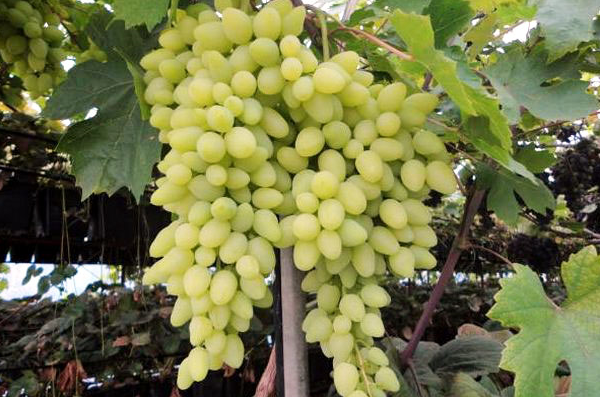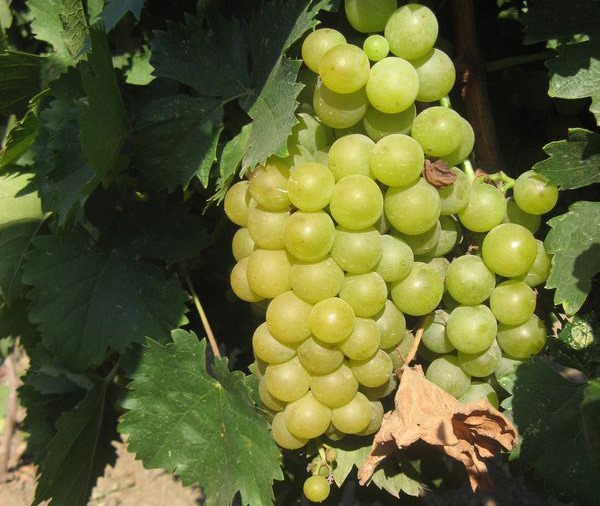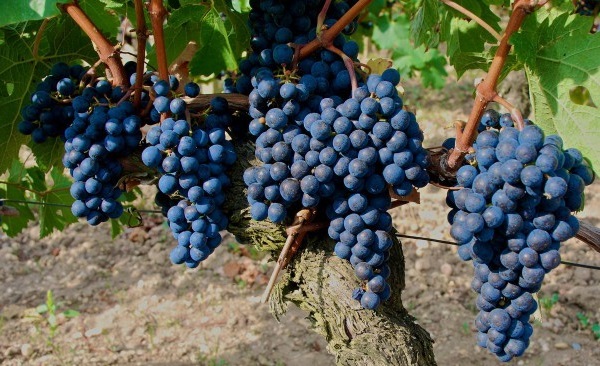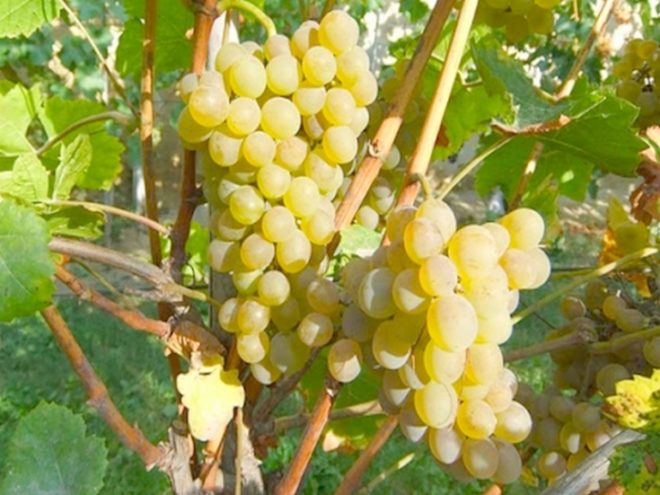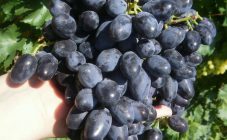Content:
The Isabella variety, according to breeders, appeared spontaneously, due to the over-pollination of the local vine and European. The grapes are widespread in Azerbaijan, Abkhazia, Georgia, Moldova, Crimea, Krasnodar region and the Volga region. Its legs are also grown in the regions of the Black Earth Region, the cold region of the Moscow Region and even harsh Siberia.
Why the variety is named so is a separate story. In 1816, a certain William Prince, a breeder from the United States, one wonderful day, was leisurely strolling through the garden of his friend Gibbs. His attention was attracted by the rich aroma emanating from the vine with dark blue berries. And then the admiring William named this grape variety Isabella, dedicating it to his friend's wife. Later he created Isabella Pink, better known as the Lydia variety. There are also white varieties of Isabella - Charvat and Noah.
Grapes came to the Soviet Union around the middle of the 20th century and began to be immediately used for making wine, which was exported to several dozen countries. But then the US said that high concentrations of methanol were seen in Isabella, which leads to multiple sclerosis and loss of vision. Many growers believe that the blame is commerce, because the grapes compete successfully with other well-known brands. Moreover, it overtakes many in the richness of its bouquet and low cost. Plus, this variety is easy to grow.
Description and characteristics of the Isabella variety
The Isabella grape is a late-ripening, uncovered, technical variety. It is consumed fresh and in the form of juices, and also used for making light homemade wine, compotes, jams and preserves.
The variety is popular due to its yield, large fruit size, excellent taste with soft strawberry notes, stability and good tolerance to common diseases (phylloxera, odium, mildew), although it can be affected by anthracnose and chlorosis.
The shape of the bunch is more often cylindrical, less often conical. A medium-sized brush, weighing up to 250 g. But with favorable weather and good care, clusters of up to 2 kg or more can be grown. The berries are dark purple or dark blue in color, round, large, up to 2 cm in diameter, covered with a gray-gray bloom with a small number of seeds. On average, berries weigh up to 3 g with sweet and sour, slightly slimy, yellow-greenish pulp. Thanks to the strong and very dense skin, the grapes are well transportable. A distinctive feature of the Isabella grape variety is the taste of berries, reminiscent of garden strawberries.
This variety ripens late. Fruits are harvested in the fall, at the beginning of October, which allows you to feast on delicious grapes, when most varieties of fruiting periods have already ended. Moreover, the fact that the berries are already ripe and are asking for in a basket will be indicated by the thinning aroma of nutmeg.
In addition to their pleasant taste, grapes have a healing effect. Grape juice contains a large amount of phytoncides, which add antibacterial properties to it. The antioxidants in berries help fight skin aging and aging.
Advantages and disadvantages of the variety
Of the advantages of Isabella, gardeners note:
- Increased frost resistance.Without sheltering, grapes can withstand frost down to -28 ° C, so that they can be grown not only in relatively warm Ukraine, Moldova and southern regions of Russia, but also in cooler regions, including in the Moscow region. If you cover Isabella for the winter, she will cope with frosts and up to -35 ° С. Young shoots damaged by return frosts in spring are replaced with new ones after 14-21 days.
- Undemanding variety for fertilizing and the specific composition of the soil. This makes it easy to care for, allowing even inexperienced gardeners to succeed in growing.
- Increased immunity. Isabella is not subject to diseases from which most varieties suffer: gray rot, powdery mildew, mildew, powdery mildew. Little is affected by phylloxera. Even if a tree affected by the disease grows nearby, this will not affect the grapes in any way.
- Resistant to waterlogged soils without rotting.
- Unpretentiousness and simplicity in reproduction. Grape cuttings take root quickly and do not require special care.
- Low calorie content, therefore can diversify the diet of the dieter.
Isabella's Disadvantages:
- Grapes react very painfully even to short-term dryness. In the future, this may result in the loss of part of the crop. Due to drought, the vine throws off some of the leaves and brushes, and the remaining bunches, although they ripen, grow small and tart.
- There should be no lime in the soil of the vineyard, therefore it is not advisable to use slaked lime to deoxidize the soil. Instead, you can add dolomite flour, finely ground egg shells or wood ash.
- It can be affected by anthracnose, therefore, autumn and spring preventive treatment is necessary.
- After 3 years, a putrid smell appears in the old wine due to the presence of certain essential oils in the berries.
Preparing the site and soil for planting seedlings
The time for planting seedlings in open ground depends on the region in which it will grow. In the southern regions, this is the first half or the beginning of the second decade of September. It is necessary to calculate the planting time in such a way that at least 2-2.5 months remain before the frost begins, so that the seedlings have time to acclimatize. For areas with a temperate climate, the best time to plant is spring.
Since grapes are not picky about the composition of soils, they can successfully bear fruit both on clay and on sandy soil. But Isabella has a negative attitude to saline or alkaline soil, lowlands. The grapes will feel best on slightly acidic soils.
When preparing a place for planting seedlings, you need to choose a site without high fences, that is, you should not plant it near a solid fence. The vines should be ventilated, but not subject to sudden gusts, for example, on gentle slopes or on low elevations.
It is necessary to arrange the vines in the western or southern direction, and also to break the vineyard away from the orchard (no closer than 6 m, especially from apple trees).
Planting seedlings
A healthy and well-formed one-year-old seedling should be 20 cm or slightly longer and have 3 to 4 roots. The length of the roots should preferably be about 15 cm. Before planting the seedlings, they are carefully examined and dry parts are cut off, and the ends are slightly shortened for healthy roots. This is done for better absorption of nutrients from the soil. The bark should not have any damage, traces of mold or rot, solid brown color.
Having chosen a place, you can start digging a planting pit 80 cm deep and the same diameter, since the roots of the grapes go 5 m deep into the soil.
A layer of crushed stone, pebbles or expanded clay is laid at the bottom of the pit to create drainage up to 7 cm thick.Pour a layer of fertile soil with humus and ash with a total thickness of up to 10 cm on top.Instead of humus and ash, potassium sulfate (70 g) and superphosphate (150 g) can be added. Cover all this once again with a 5 cm layer of earth, then again fertilize and cover with soil, making only 5 such layers. Water the pit thoroughly with plenty of water up to 100 liters.

Before planting, a layer of crushed stone or expanded clay is laid on the bottom of the pit to create drainage
Before planting, the roots of the seedlings are dipped in a mash made of manure and clay (the consistency of sour cream) and dried for 2 hours. In the middle of the pit, you need to install a small peg 20 cm higher than the seedling and pour water up to 25 liters into the pit. When the water is absorbed, you need to stick in the seedling, but care should be taken not to fill up the point where the shoots start branching. It is better if it is 4 cm higher than the soil.
If the seedlings are up to 30 cm, they need to be planted vertically, and those that are higher, tilted at an angle of 45 °. Then you need to shorten the tops of the shoots by 5-6 buds (this is approximately 20 cm) and tie the sprout well to the peg. Finally, pour 4 or 5 buckets of water again.
After complete absorption of moisture around the seedling, you need to spread the mulch: old straw, hay, sawdust and cover the seedling with something for 15-20 days, for example, with a plastic bottle.
Young plants need to be watered once a week, preferably in the evenings, 1.5-2 buckets per bush.
Propagated grapes using cuttings or layering.
Despite the fact that the variety was bred several years ago, many gardeners continue to grow it with pleasure and see only benefit and benefit in this. Indeed, if properly looked after, Isabella will always respond with a rich harvest of fragrant bunches.




